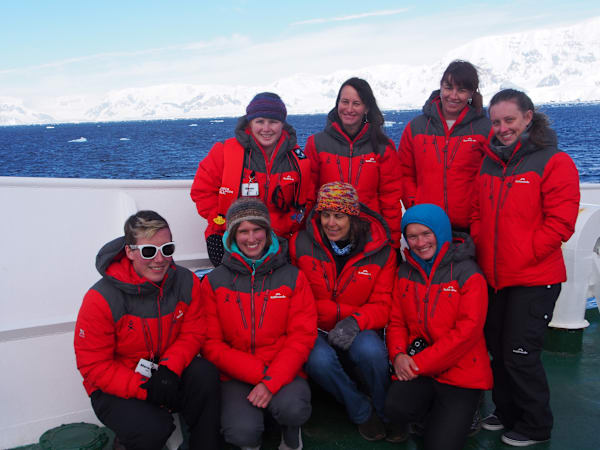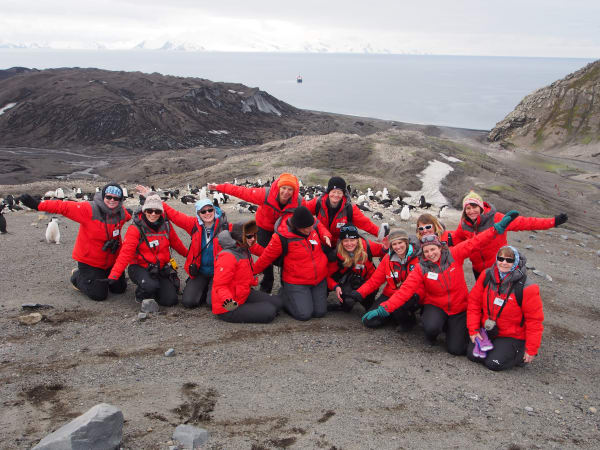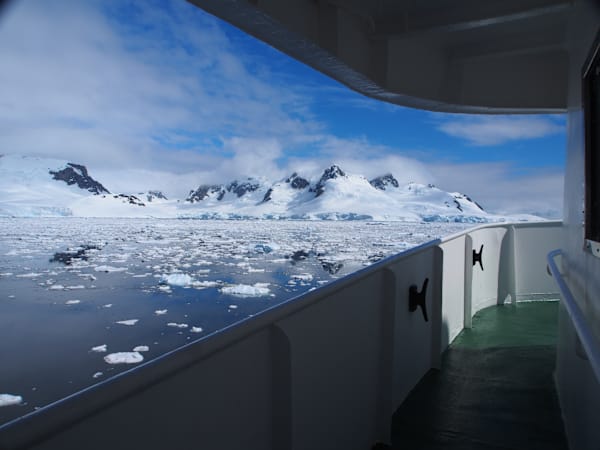Photographer Dr Mary-Anne Lea
Historically, the world has been run by men and in a masculine way. Indeed, recent global politics would suggest a resurgence in destructive, predominantly male power games. Let’s face it – planet- and people-destroying decisions are generally made by men. Perhaps then, a more sustainable and peaceful world would be more likely if there was a more feminine approach to power, decision-making and our interactions with the planet and with each other. The creators of Homeward Bound believe so and they are doing something about it.
Homeward Bound’s inaugural program was launched in 2016 with the first 76 of a targeted 1,000 women from around the world. All with critical science backgrounds, they would “undertake a year-long state-of-the-art program to develop their leadership and strategic capabilities, using science to build conviction around the importance of their voices”.
Tasmania was prominent. Of the first 76 women, six were Tasmanians, and another three were part of the organizing team for the science component. Tasmania, particularly Hobart, punches well above its weight in the sciences.
The program culminated in the largest-ever female expedition to Antarctica, a three-week voyage in December 2016, which left from Ushuaia on the Argentine side of Tierra del Fuego. Her Excellency Professor the Honourable Kate Warner, Governor of Tasmania and Patron of Homeward Bound, hosted an event at Government House to see off and celebrate the Tasmanian participants. The women undertook a stream of lectures and workshops on board.
The program for the trip comprised four key components: leadership; personal strategy; ‘visibility’; and science. The personal strategy sessions helped participants to identify key areas and goals in their lives, both personal and professional. The visibility sessions were about why and how to build a public profile, to further their objectives.
Three Tasmanians, Dr Mary-Anne Lea and Dr Justine Shaw (who went on the trip) and Dr Jess Melbourne-Thomas (who was not on board), prepared and led the science component, which included visits in Antarctica to Argentina’s Carlini Base and America’s Palmer Station. Interacting with polar scientists on bases enabled discussion on current research in the region and the challenges faced by scientists. “Seeing the extent of glacier retreat near the Carlini Station was a stark reminder of why we were all there, of what we have to lose,” said Molly Christensen, who works in aquaculture research at the Institute for Marine and Antarctic Studies in Hobart.

The principal goal of the science component was to educate participants about aspects of global change and biological systems through expert lectures, with a focus on current research in Antarctica, but it was also about creating inter-disciplinary links.
Justine Shaw and Mary-Anne Lea organised a “symposium at sea” in which the 76 travellers had three minutes each to speak either on their research or on a key message. “This component was extremely stimulating … particularly given the diversity of expertise,” Lea said.
“A highlight for me was getting to know and learn from 76 amazing women … the science was of such a high standard, and it was communicated with such passion and insight,” Shaw said.
So why women, science and Antarctica?

Globally, women are under-represented in leadership positions, and while this has been recognised in many countries, change remains very slow. Women today make up a far greater percentage of graduates and our workforce than ever before, but they remain an extreme minority in positions of power and executive decision making roles. Part of the thinking behind Homeward Bound is that by giving talented and motivated women “leadership and strategic skills, a sound understanding of the science, and a strong, purposefully-developed network, they will be able to impact policy and decisions towards a sustainable future”, says the Homeward Bound manifesto.
The organisation’s name comes from the desire to create a greater focus on the concept of a “global home”. Supporting women in science is considered to be one way of achieving this, because improving participants’ “clarity, confidence, shared vision and strategic capability will enhance their opportunity to take up leadership roles globally and proactively contribute to a sustainable world”.
“It’s not that men can’t or won’t do this,” the Homeward Bound manifesto says. “However, when time is short, it would seem that an enhanced diversity in leadership teams, by ensuring more women are at the executive table, might serve us all.”

Over the next ten years, Homeward Bound wants to build a global collaboration of 1,000 women who have a scientific background and support them into leadership roles. It then aims to encourage them to help shape policy and decision-making, networked to each other, each in their own way working for change and all collaborating toward a shared vision.
Setting this initiative against the backdrop of Antarctica makes sense. Regions of Antarctica are currently showing amongst the fastest responses to climate change on the planet, and the study of Antarctica and the Southern Ocean, and their roles in the climate system, provides critical insights into global-scale change, and the influence of human activities on environmental change.
But there is also a simpler reason: Antarctica is a wild, stunning and unique environment that captures the imagination and inspires people. Visiting Antarctica is an epic journey, creating an experience it is hoped will create strong bonds, inspire action and lead to long-term, change-making collaborations between the women. It’s also a location that makes disconnection from social media, emails, phones and the distractions of daily life easy.

Homeward Bound is the work of four women; Antarctic ecologists Drs Mary-Anne Lea and Justine Shaw, Fabian Dattner, a leadership activist and partner at Melbourne-based management consulting firm Dattner Grant, and Jess Melbourne-Thomas, who is an Antarctic marine ecological modeler. Fabian and Jess, who met at a conference in Hobart in 2013, were both interested in how to achieve change around the representation of women in leadership.
“Faby had a dream about taking a boat-load of women to Antarctica,” Melbourne-Thomas said. “I could hardly say ‘no’ to something that exciting.”
The two women recognised that the complex and intertwined problems of population growth, overconsumption, pollution, ecosystem destruction, disease, extinction and of course climate change that our world currently faces require more than novel scientific solutions. They require collaborative leadership, diverse thinking and creative approaches. Homeward Bound is part of a wave of emerging initiatives to help level the playing field for women and to facilitate increased diversity in leadership.

Dattner and Melbourne-Thomas begun building a team, and within six months had gained the support of significant scientific bodies and women of influence. The project was launched globally in February 2015, and by mid-2015 the inaugural program was fully subscribed. The 76 women selected from around the world included astronomers, engineers, physicists, science communicators, Antarctic and Arctic specialists, doctors and social scientists.
The project is supported by a global faculty comprising experts in various domains. They include primatologist and environmental campaigner Dr Jane Goodall, film-maker Franny Armstrong, marine biologist and explorer Dr Sylvia Earle, former executive secretary of the United Nations Framework Convention on Climate Change Christiana Figueres, and Australian singer and activist Clare Bowditch. The organisation is predominantly funded by Dattner Grant, various philanthropists and universities.
It is an investment, they say, in a shared future. Imagine a global network of 1,000 women, with multiple collaborations within that network, with each member having skills in designing and executing strategy, leadership capabilities and an understanding of what is happening to our planet. Imagine each of those 1,000 women spreading their knowledge, strategies and inspiration amongst all their own networks. Only positive things can grow from this.
The Homeward Bound #TEAMHB6 began their journey March 8, 2021. You can read more about that, and about the organisation, at homewardboundprojects.com.au.
This article was first published in issue 84 of Forty South magazine.
James Dryburgh: A publisher once told James that when he is asked for his bio, he should say: “James writes subversive essays about important things.” James felt a bit awkward about saying this publicly, but secretly he liked it. He has written for many publications. His books are Essays from Near and Far, Walleah Press, 2014 and The Balfour Correspondent, Bob Brown Foundation, 2017.
Dr Mary-Anne Lea is an Associate Professor at the Ecology and Biodiversity Centre at the Institute for Marine & Antarctic Studies at the University of Tasmania and a Homeward Bound co-founder, Board member and co-lead of the Science stream.









